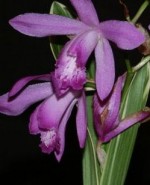 Not all orchids are persnickety prima donnas and this one is definitely not. A native of Japan, China, Korea, and Burma, this hardy, terrestrial orchid was introduced into to England in the late 18th century and thence into North America where it grows well in zones 6-9. It is easy to grow and spreads by rhizomes into a good-looking clump two feet across in about five years. The pinkish-purple flowers look like small versions of cattleya orchids and are borne in loose clusters of 3-10 on 18” naked stems in mid to late spring. Three to six pleated linear leaves are produced by each rhizome in early spring but may damaged by early frosts. This hardy orchid is a good addition to gardens with part shade and even moisture, and is attractive in containers.
Not all orchids are persnickety prima donnas and this one is definitely not. A native of Japan, China, Korea, and Burma, this hardy, terrestrial orchid was introduced into to England in the late 18th century and thence into North America where it grows well in zones 6-9. It is easy to grow and spreads by rhizomes into a good-looking clump two feet across in about five years. The pinkish-purple flowers look like small versions of cattleya orchids and are borne in loose clusters of 3-10 on 18” naked stems in mid to late spring. Three to six pleated linear leaves are produced by each rhizome in early spring but may damaged by early frosts. This hardy orchid is a good addition to gardens with part shade and even moisture, and is attractive in containers.
Type: Herbaceous perennial
Bloom: Three to ten pinkish-purple flowers 1-1½” across are borne on naked scapes in mid to late spring and persist for 2-3 weeks.
Foliage: Three to five pale green, sword-shaped leaves 12” long are pleated and papery.
Size: 8-12” H x 10” W
Light: Full sun to part shade (where summers are hot)
Soil: Average, humus-rich, moist, well-drained; dry conditions in summer may result in poor flowering the following spring.
Hardiness: Zones 6-9 (5 with protection)
Care: Easy care; protect from early frosts
Pests and Diseases: None of significance but slugs and snails can be a nuisance.
Propagation: Division in fall
Companion plants: Ferns, bleeding heart, heucheras, hosta, primula,
Outstanding Selections:
 var. alba (white)
var. alba (white) ‘Albostriata’ (white edged leaves)
‘Albostriata’ (white edged leaves)